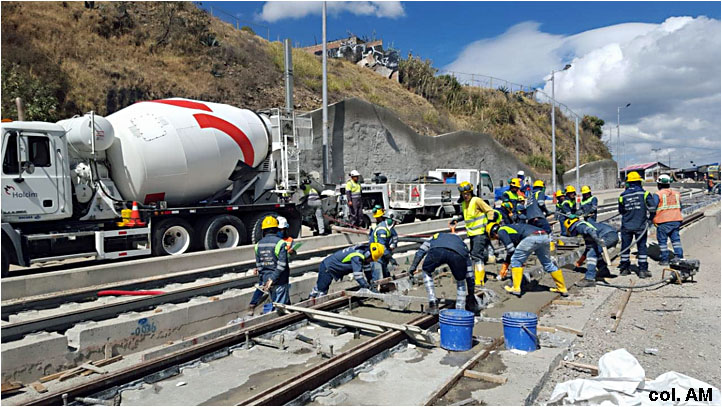The New Tramway in
CUENCA, ECUADOR
BY
Allen Morrison
Ver versión en español
See this page with text in Georgian:
ახალი ტრამვაი კუენკა, ეკვადორში
See this page with text in Lithuanian:
Žiūrėkite versiją lietuvių kalba
Cuenca is Ecuador's third largest city (after Guayaquil and Quito) and is the capital of Azuay province in the south, near Ecuador's disputed border with Peru. At altitude 2,550 m/8,366 ft, it is one of the world's highest large cities. Current population is about 400,000. The region has been inhabited since at least 8000 BC and for 3,000 years was ruled by the Cañari and Incas. The latter named their capital Tomebamba, which because of its riches some think was the mythical city of El Dorado. The Spaniards conquered the Incas and founded Santa Ana De Los Cuatro Ríos De Cuenca in 1557. (The city is traversed by four rivers: see map.) Because of its relatively remote location, Cuenca did not develop like other Ecuadorian cities and has retained much of its colonial architecture and style. UNESCO declared its historic center a World Heritage Site in 1999. Cuenca was not reached by railroad or paved highway until the 1960s and never before had a street railway. Today it is building the Tranvía de Los Cuatro Ríos – the Tramway of the Four Rivers, which will be the highest street railway in the world:
Plans for a tramway in Cuenca were first reported in an Informe of its municipal government in 2009. In 2010 it engaged Artelia of France for studies and in 2013 signed a contract with Alstom of France to build a 10.3 km electric tram line between the city's north and south sides [see map]. Alstom supplied fourteen 5-car 108-ft/33-m 300-passenger Citadis model 302 trams, which will use APS (Alimentation Par le Sol), rather than overhead wires, on the narrow streets of the historic center. Construction began in 2013 and the first Citadis tram, number 1001, arrived at the new tramway shops on Av. México [see map] on 1 July 2015 [Xavier Ochoa]: |

The municipal government is enthusiastic about the project and has supplied interesting information to the public:
Here is a view of the driver's control panel – taken at the Alstom plant in La Rochelle, France, before construction had been completed and the vehicle was shipped to Ecuador [Alstom]:
Tranvía 1001 was formally presented at the shops on Av. México [see map] on 9 July 2015 [Municipio de Cuenca]:
More trams continued to arrive. Here is 2/5 of number 1011. The llamas seem to approve [Xavier Ochoa]:
A half-dozen trams were in Cuenca by September, although there was no overhead wire yet in the yard [see map] [Municipio de Cuenca]:
Wire was installed and power was connected in October [Unsión TV]:
The big event finally took place on Friday morning 23 October 2015. Alstom engineer Philippe Guinand took the controls of tranvía 1001 as it prepared to leave the shops for the very first time [Xavier Ochoa]:
|

|

|
By
late October the Cuenca tramway fleet consisted of nine vehicles. Number 1009 tested on Monday 26 October 2015 [Xavier Ochoa]:
3 November 2015 was Independence Day in Ecuador – the 195th anniversary of its separation from Spain. Trams 1001 and 1003 provided free rides all day – although they could run only on the southern end of the line, since construction of the APS sections in the center had not yet been completed [see map]:
Tram
1014, the last of the 14 units ordered from
Alstom, arrived on 30 December, completing the fleet. Residents
gathered at every sign of progress. Most had never
seen a tram before (Ecuador's last tram ran in Guayaquil in 1951):
Construction
of
the system continued in 2016, but was interrupted for contractural and
financial reasons on 14 October of that year. There was no activity on
the line for eleven months. A new Alstom consortium called
ACTN Tranvía Cuenca was formed on 18 September 2017 and a new USD $48 million contract was signed the following 5 December [ACTN]:
The
new plan specified that ACTN must complete and place the system in full
commercial operation within 300 days of the signing –
which meant that Inauguration Day would be on or before 3 November
2018. ACTN published this image – showing a section of the wire-free APS
track on Calle Gran Colombia [see map] – in an effort to appease the impatient residents:  The new wireless APS sections – which connected the north and south sides of town [see map] –
were finally inaugurated on 22 July 2018. It was party time in Cuenca.
In the second photograph note the folded pantograph above the
middle car ["Galahad" via SkyscraperCity]:
|


|
Most of the south side of the line, which uses overhead wire, had been completed [see map] [col. AM]:
 But there was still much work to do on the north, along Av. España near the airport, and in the hilly section around the bridge over Río Milchichig [see map] [Tranvía Cuenca]:
Alas, new technical problems arose and the 3 November deadline seemed impossible. In August 2018 Tranvía Cuenca signed a $3.5 million contract with Metropolitano de Tenerife, the tramway operator in Santa Cruz de Tenerife, capital of the Canary Islands (Spain). According to the new arrangement, MT will complete construction by March 2019 and operate Tranvía Cuenca for the next 3 1/2 years [Tranvía Cuenca]:
To be continued...
The author wishes to express his gratitude to Cuenca resident Xavier Ochoa for his extraordinary contributions to this page.
[ Ver versión de esta página en español ] [ See version of this page in Lithuanian ] See my index of If you have comments, criticism or suggestions,
This site was first placed online Copyright © 2015-2115 Allen Morrison |















